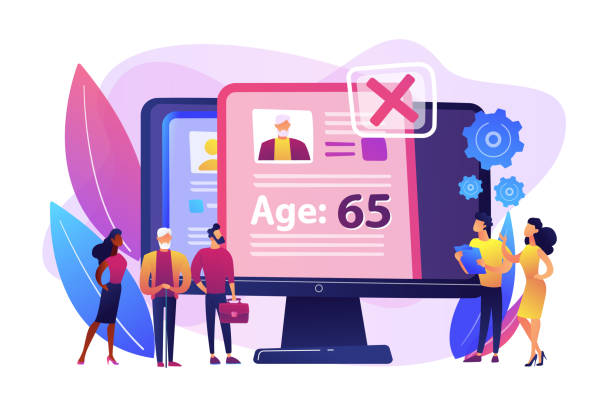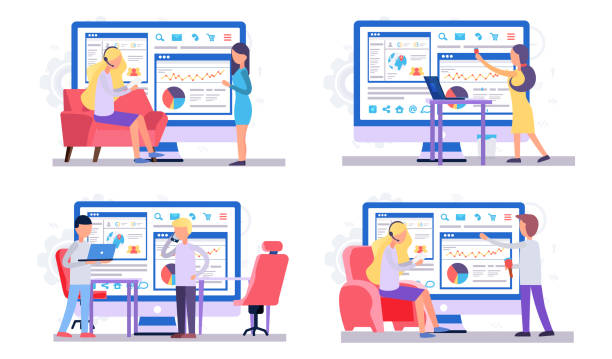Introduction to Responsive Website Design and Its Importance in the Digital Age

In today’s world, where access to the internet takes place through various devices such as mobile phones, tablets, laptops, and even smart TVs, responsive web design is no longer a luxury option, but an undeniable necessity.
The concept of responsive web design means that a website can automatically and intelligently adapt its appearance and layout to the user’s device screen size, without the need for horizontal scrolling or zooming.
This feature means providing a unified and optimized user experience for all visitors, regardless of the tool they use to visit.
The importance of this approach becomes clear when we know that a large portion of global web traffic comes from mobile devices.
If your website is not displayed correctly on mobile, users will quickly leave it and go to your competitors.
This not only leads to a decrease in site traffic but also harms your brand’s credibility and sales.
Google, as the leading search engine, prioritizes responsive websites in its ranking, because Google’s main goal is to provide the best possible experience to its users.
Therefore, every online business must pay special attention to adaptive website design for survival and growth in this competitive space.
This is a fundamental step towards online success and demonstrates professionalism and understanding of today’s user needs.
Does your current corporate website not reflect your brand’s credibility and power as it should? Rasawob solves this challenge for you with professional corporate website design.
✅ Increase visitor credibility and trust
✅ Targeted attraction of more customers
⚡ Click for free consultation!
Principles and Fundamentals of Responsive Design

Behind every successful responsive web design, there is a set of principles and technical foundations that work together to make the website flexible.
The three main pillars of this approach are: Fluid Grids, Flexible Images, and Media Queries.
Understanding these concepts is essential for any developer and designer who intends to enter the world of responsive design.
Fluid grids mean that instead of using fixed pixel units for element width, relative units like percentages are used.
This causes the page layout to change proportionally with screen size changes, and website elements never go out of frame or create excessive empty space.
Flexible images are also a complement to fluid grids.
As their name suggests, these images are designed to change their dimensions as their containing container changes size.
This is usually done by setting the `max-width: 100%` property in CSS for images, so they never become larger than their container dimensions and automatically resize.
Finally, media queries are the main driving force behind adaptive websites.
This CSS3 capability allows developers to apply different styles based on specific characteristics of the user’s device; characteristics such as screen width, height, orientation (portrait or landscape), and even resolution.
For example, it can be determined that on smaller screens, the navigation menu is displayed as a hamburger menu, and on larger screens, horizontally.
These three principles together provide the ability to create an unparalleled user experience on any device and form the core of every professional responsive website design.
Differences Between Responsive Design and Separate Mobile Websites

Before the advent and widespread adoption of responsive web design, many businesses used to build separate mobile websites to provide a better experience for their mobile users.
This approach involved developing a completely separate version of the website, usually at subdomains like `m.example.com`.
Although this method was a solution to the mobile display problem at the time, it came with significant challenges and disadvantages that responsive web design has resolved.
The main difference is that responsive design uses a single codebase and a single URL for all devices, while separate mobile websites have two separate codebases and two separate URLs (one for desktop and one for mobile).
This fundamental difference has important implications for maintenance, SEO, and user experience.
Maintaining two separate websites means twice the work in updating content, fixing bugs, and implementing new features.
This process is time-consuming and costly and increases the likelihood of errors.
In terms of SEO, Google has increasingly moved towards Mobile-First Indexing and prefers to crawl and index a website with a single URL and a responsive experience.
Having two versions of the website can confuse search engines and lead to issues such as Duplicate Content, unless Canonicalization is properly configured.
Below, a more comprehensive comparison is provided in table format, highlighting the key differences between these two approaches.
This deep understanding helps decision-makers choose the best strategy for their online presence.
| Feature | Responsive Website Design | Separate Mobile Website (m.example.com) |
|---|---|---|
| Number of URLs | One URL for all devices | Two separate URLs (main and m.subdomain) |
| Codebase | A single codebase | Two separate codebases |
| Development and Maintenance Cost | Lower (due to integration) | Higher (due to need for two teams/phases) |
| SEO | Optimized for Google Mobile-First Indexing, no duplicate content issues | Requires precise Canonical and Redirect settings to prevent SEO issues |
| User Experience (UX) | Integrated and consistent experience across all devices | May be a different experience, possibility of losing some desktop version features |
| Future-Proofing | Standard and forward-looking approach for web development | Older approach, less recommended currently |
Challenges and Solutions for Implementing Responsive Design

Despite the many advantages of responsive web design, its implementation is not without its challenges.
One of the biggest obstacles is ensuring optimal website performance across different devices, especially mobile phones with less bandwidth.
Large image sizes and JavaScript resources can severely reduce page load speed, which directly affects user experience and SEO ranking.
The solution to this problem lies in image optimization through compression, using next-generation formats (like WebP), and implementing the `srcset` or `picture` feature in HTML to provide images with different resolutions based on screen size.
Another challenge is designing an appropriate user experience for each breakpoint.
What looks great on a desktop may be confusing or unusable on mobile.
This requires a Mobile-First design approach, meaning starting the design for the smallest screens and then gradually expanding it for larger screens.
This approach ensures that the most important content and functionalities are accessible to mobile users.
Also, thorough testing on real devices and various browsers is essential to identify and fix problems.
Tools such as Google Chrome DevTools, BrowserStack, and Lambdatest can be helpful in this regard.
Finally, the issue of CSS and JavaScript complexity also arises; excessive and unoptimized code can lead to performance problems.
Using lightweight frameworks, code optimization, and utilizing lazy loading techniques for images and videos are all solutions to overcome these challenges and achieve a successful responsive design.
Tired of losing business opportunities due to not having a professional corporate website? Don’t worry anymore! With Rasawob’s corporate website design services:
✅ Your brand’s credibility and professionalism will increase.
✅ You will attract more customers and sales leads.
⚡ Get a free website design consultation now!
Impact of Responsive Website Design on User Experience (UX)

As mentioned earlier, user experience or UX is the core of any successful website, and responsive web design has a profound impact on it.
The main goal of an adaptive website is to provide a consistent and seamless experience to users, regardless of the device they use to browse the web.
Imagine a user viewing your website on a laptop, suddenly opening the same site on their smartphone.
If the website is responsive, the user can easily read the content, click on buttons, and fill out forms without any effort.
This unified experience creates a sense of trust and professionalism in the user’s mind.
One of the most important UX benefits resulting from responsive design is the reduced need for zooming and horizontal scrolling.
Nothing is worse than having to zoom in or drag the page left and right to read a paragraph on a mobile phone.
Responsive web design solves this problem by automatically adjusting content width and fonts.
In addition, responsive design also helps with website accessibility.
By ensuring that all elements are clickable and readable, even for people who may have poor vision or motor difficulties, your website will be usable by a wider range of users.
This approach means user time savings, as there is no need to search for a mobile version of the site or struggle to use an unsuitable interface.
As a result, users stay on your site longer, view more pages, and are more likely to become loyal customers.
The Role of Responsive Design in SEO and Google Ranking

In the current digital age, every website seeking to achieve online success must pay special attention to SEO (Search Engine Optimization).
Responsive web design not only improves user experience but also plays a vital role in search engine optimization and increasing your site’s ranking in Google results.
Since 2015, Google officially announced that mobile-friendliness is one of the ranking factors for mobile searches.
This issue peaked in 2018 with the introduction of Mobile-First Indexing, meaning Google primarily considers the mobile version of your website for crawling and indexing, not its desktop version.
The existence of a responsive web design means that you have only one URL and one codebase for all devices.
This helps Google easily crawl and index your content and prevents issues like duplicate content that can harm SEO ranking.
Also, responsive websites usually have a lower bounce rate because users have a positive experience and are more likely to stay on the site.
Page load speed, an important factor in Google ranking, can be achieved in responsive websites with proper implementation of image optimization and lightweight code.
Finally, responsive websites often perform better on Google’s Core Web Vitals metrics, which include speed, visual stability, and interactivity.
All these factors combined make responsive web design an essential component of any successful SEO strategy.
Popular Tools and Frameworks for Responsive Website Design

To effectively implement responsive web design, a set of tools and frameworks have been developed that greatly simplify the work of developers.
These tools, by providing ready-made functionalities and predefined structures, enable faster and more optimized development of responsive websites.
One of the most famous and widely used frameworks in this field is Bootstrap.
Bootstrap is a powerful CSS and JavaScript framework that, with a 12-column grid system, ready-made components (such as navigation bars, forms, cards), and JavaScript plugins, allows for building fully responsive websites in the shortest possible time.
In addition to comprehensive frameworks, newer CSS techniques such as Flexbox and CSS Grid have also revolutionized how elements are laid out in responsive website design.
Flexbox is designed for one-dimensional layout (row or column) and Grid for two-dimensional layout (rows and columns simultaneously), offering tremendous flexibility in controlling page elements, especially in response to different screen sizes.
Tools like Tailwind CSS, with their Utility-First approach, also allow developers to quickly apply responsive styles using small, composable CSS classes, without the need to write much custom CSS.
These tools, along with advanced code editors and browser development tools, provide a rich ecosystem for anyone looking for adaptive web design.
In the table below, some of these tools and their uses for responsive website design are introduced.
| Tool/Framework Name | Type | Main Use in Responsive Design |
|---|---|---|
| Bootstrap | CSS/JS Framework | Strong grid system, ready-made responsive components, rapid development |
| Flexbox (CSS) | CSS Module | One-dimensional element layout, space distribution and content alignment |
| CSS Grid | CSS Module | Two-dimensional element layout (grid-based), precise control of rows and columns |
| Tailwind CSS | Utility-First CSS Framework | Creating responsive styles with utility classes, high flexibility |
| Google Chrome DevTools | Browser Tool | Simulating various devices, real-time responsiveness testing, debugging |
| Figma/Sketch/Adobe XD | UI/UX Design Tools | Designing and prototyping responsive user interfaces before development |
The Future of Web Design with a Focus on Advanced Responsiveness

The world of web design is rapidly evolving, and every day we encounter new technologies.
Although responsive web design has become an industry standard, the future of the web goes beyond this concept and moves towards advanced responsiveness and personalized experiences.
The question is, in the future, how can an adaptive website become even smarter and more efficient? One important trend is the development of Progressive Web Apps (PWAs), which offer a combination of the best features of the web and native applications.
PWAs can work offline, send push notifications, and even be installed on the user’s device home screen, all while leveraging responsiveness principles to display optimally at any size.
In addition to PWAs, the focus on performance will become much deeper.
Techniques such as Server-Side Rendering (SSR) and Static Site Generation (SSG) will become more important for delivering content faster to users, especially on mobile.
Also, with the advancement of artificial intelligence and machine learning, we may see the emergence of websites that dynamically adjust their layout and content based on each user’s behavior and preferences; a level of responsiveness that goes beyond just screen size.
These changes promise an exciting future for responsive web design, where websites not only respond to screen size but also to the individual needs and expectations of users.
Are you tired of your company’s website not meeting your expectations? With Rasawob, design a professional website that truly represents your business.
✅ Increase the attraction of new customers and sales leads
✅ Enhance your brand’s credibility and trust with your audience
⚡ Get a free website design consultation!
Key Tips for Successful Responsive Website Design

Achieving a responsive web design that is both technically robust and provides an unparalleled user experience requires adherence to several key tips.
The first and most important step is Mobile-First thinking.
Instead of designing for desktop first and then trying to squeeze it into mobile, start by designing for the smallest screens and then gradually expand it for larger devices.
This approach ensures that the most important elements and functionalities are accessible to mobile users.
Second, optimize images and media.
High-volume images can severely slow down site loading speed.
Use image compression tools and make sure to utilize `srcset` or `picture` features in HTML to provide appropriate image sizes for different devices.
Also, paying attention to font size and element spacing (Padding and Margin) is essential for better readability on smaller screens.
Clickable elements like buttons and links should be large enough to be easily touched with a finger.
Using appropriate typography that is readable at various sizes is of particular importance.
Finally, repeated and realistic testing on real devices and various browsers is key to identifying and resolving potential problems.
A successful responsive website design is the result of careful planning, intelligent implementation, and continuous testing, which is essential as ongoing educational content for design and development teams.
Responsive Design in Local SEO

In today’s competitive world, not only global SEO but also Local SEO is of vital importance for many businesses, especially those with physical branches.
Responsive web design directly impacts the success of your local SEO strategy.
Most local searches, such as “best restaurant near me” or “hairdresser in [city name]”, are performed via mobile devices.
If your website is not displayed correctly on mobile and users cannot easily find your contact information, business hours, or address, you will quickly lose potential customers.
Google places great importance on mobile user experience and page load speed in ranking local search results.
A responsive web design that loads quickly and provides key information in a readable and accessible format will have a higher chance of appearing in the top local search results.
Also, responsive websites, due to having a single URL, make managing your Google My Business profile and ensuring the accuracy of information across different platforms easier.
Ensuring that maps, phone numbers, and contact forms work correctly in the mobile version is of high importance.
An adaptive website allows businesses to more effectively connect with their local customers and attract them to their business, which is a critical factor in sales growth and increased brand awareness in a specific area.
Frequently Asked Questions
| Question | Answer |
|---|---|
| What is Responsive Website Design? | Designing a website whose appearance and layout automatically adapt to the user’s device screen size (such as computer, tablet, mobile) to provide an optimal user experience. |
| Why is Responsive Design important? | Given the variety of devices users employ to view websites, responsive design improves user experience, reduces bounce rate, increases time spent on the site, and enhances SEO. |
| What are the main principles of Responsive Design? | The three main principles include Fluid Grids, Flexible Images, and Media Queries. |
| What is a Media Query and what is its role in Responsive Design? | A Media Query is a CSS capability that allows you to apply different styles based on display device characteristics such as screen width, height, resolution, and media type. This tool is considered the heart of responsive design. |
| What is the difference between Mobile First and Desktop First approaches in Responsive Design? | In the Mobile First approach, design and coding are first done for small screens (mobile), and then styles are added for larger screens using media queries. In the Desktop First approach, the opposite is done; first designed for desktop and then adapted for smaller screens. The Mobile First approach is generally recommended. |
And other services of Rasa Web advertising agency in the field of advertising
Appropriate pricing strategies for medical product advertisements
Importance of providing technical details in medical product advertisements
How to increase ad views for medical products on classifieds websites
Difference between free and paid ads for medical product sellers
How to build customer trust in classifieds ads
And over a hundred other services in the field of online advertising, advertising consultation, and organizational solutions
Online Advertising | Advertising Strategy | Advertorials
🚀 Transform your business’s digital presence with Rasa Web’s online advertising and advertorial strategies.
📍 Tehran, Mirdamad Street, next to Bank Markazi, Kazerun Jonoubi Alley, Ramin Alley, No. 6

